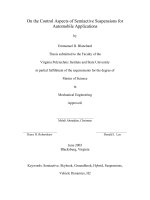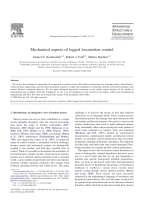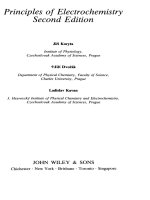Modern aspects of electrochemistry no 34 conway
Bạn đang xem bản rút gọn của tài liệu. Xem và tải ngay bản đầy đủ của tài liệu tại đây (1.49 MB, 296 trang )
MODERN ASPECTS OF
ELECTROCHEMISTRY
No. 34
LIST OF CONTRIBUTORS
ZBIGNIEW KOCZOROWSKI
Department of Chemistry
Warsaw University
02-093 Warsaw, Poland
ISAO OKADA
Department of Chemistry
Sophia University
Tokyo 102-8554 Japan
CLAUDE LAMY
Electrochimie et Interactions
Universiteé de Poitiers
Poitiers, 86022 France
MICHAEL SPIRO
Department of Chemistry
Imperial College of Science, Technology &
Medicine
London SW72AY, United Kingdom
JEAN-MICHEL LÉGER
Electrochemie et Interactions
Université de Poitiers
Poitiers, 86022 France
BRENDA J. LITTLE
Department of Navy
Naval Research Laboratory
Stennis Space Center
Mississippi 39529-5004
SUPRAMANIAN SRINIVASAN
Electrochemie et Interactions
Université de Poitiers
Poitiers, 86022 France
PATRICIA A. WAGNER
Department of Navy
Naval Research Laboratory
Stennis Space Center
Mississippi 39529-5004
A Continuation Order Plan is available for this series. A continuation order will bring delivery
of each new volume immediately upon publication. Volumes are billed only upon actual
shipment. For further information please contact the publisher.
MODERN ASPECTS OF
ELECTROCHEMISTRY
No. 34
Edited by
J. O’M. BOCKRIS
Molecular Green Technology
College Station, Texas
B. E. CONWAY
University of Ottawa
Ottawa, Ontario, Canada
and
RALPH E. WHITE
University of South Carolina, Columbia
Columbia, South Carolina
Kluwer Academic Publishers
New York, Boston, Dordrecht, London, Moscow
eBook ISBN:
Print ISBN:
0-306-46923-5
0-306-46462-4
©2002 Kluwer Academic Publishers
New York, Boston, Dordrecht, London, Moscow
All rights reserved
No part of this eBook may be reproduced or transmitted in any form or by any means, electronic,
mechanical, recording, or otherwise, without written consent from the Publisher
Created in the United States of America
Visit Kluwer Online at:
and Kluwer's eBookstore at:
Preface
The current volume of this series continues to exhibit the main characteristic of the previous volumes: It covers the frontier in several widely
differing sections of the huge area of modern electrochemistry.
Thus, the first chapter touches on an aspect of electrochemistry for
which the author has become justly well known: application of the Wagner
and Traud theorem of 1938 according to which electrochemical systems
may function on a single electrode. In the next chapter, the article by
Koczorowski treats a seldom-visited but truly fundamental area, that of
voltaic measurements at liquid interfaces.
Chapter 3 is bound to attract the attention of the clean energy engineer
because it concerns the ultimate fuel cell—one that uses the oxidation of
an organic fuel directly without having to go through a reforming stage to
produce the hydrogen fuel for the fuel cell. Success here would have a
very significant effect upon the burgeoning enterprise of fuel cell-powered
cars.
We are particularly pleased to welcome the article by Okada on
dynamic processes in molten salts because it represents the culmination
of the efforts of Professor Chemla at the Sorbonne to arrange such an
article.
Finally, it is stimulating to read the article by Little and Wagner
because of the prominence attached to microbial action in the electrochemistry of the 1990s and because it has hitherto been difficult to find
an electrochemically oriented presentation of this topic.
J. O’M. Bockris
Molecular Green Technology
College Station, Texas
B. E. Conway
University of Ottawa
Ottawa, Ontario, Canada
Ralph E. White
University of South Carolina
Columbia, South Carolina
v
This page intentionally left blank.
Contents
Chapter I
A CRITIQUE OF THE ADDITIVITY PRINCIPLE FOR MIXED
COUPLES
Michael Spiro
I.
II.
III.
IV.
V.
VI.
Introduction . . . . . . . . . . . . . . . . . . . . . . . . . . . . . . . . . . . . . . . . . . . . . . . . . . 1
The Additivity Principle . . . . . . . . . . . . . . . . . . . . . . . . . . . . . . . . . . . . . . . 1
Earlier Tests . . . . . . . . . . . . . . . . . . . . . . . . . . . . . . . . . . . . . . . 3
Selected Corrosion and Electroless Plating Studies . . . . . . . . . . . . . . 4
Heterogeneous Catalysis of Redox Reactions . . . . . . . . . . . . . . . . . . 6
Conclusions . . . . . . . . . . . . . . . . . . . . . . . . . . . . . . . . . . . . . . . . . . . . . . . . . 9
References . . . . . . . . . . . . . . . . . . . . . . . . . . . . . . . . . . . . . . . . . . . . . . . . . . 11
Chapter 2
VOLTAIC CELLS IN ELECTROCHEMISTRY AND SURFACE
CHEMISTRY OF LIQUIDS
Zbigniew Koczorowski
I.
II.
III.
IV.
V.
VI.
VII.
VIII.
Introduction . . . . . . . . . . . . . . . . . . . . . . . . . . . . . . . . . . . . . . . . . . . . . . . . . 13
Electrified Interfaces and Their Electrical Potentials . . . . . . . . . . . . 14
Volta Potential and Voltaic Cells . . . . . . . . . . . . . . . . . . . . . . . . . . . 16
Experimental Methods for Investigating Voltaic Cells . . . . . . . . . . . 20
Volta Potential of the Metal/Solution Interface. . . . . . . . . . . . . . . . . 23
Real Potentials of Ions in Electrolyte Solutions . . . . . . . . . . . . . . . . 24
Real Ion Activity. . . . . . . . . . . . . . . . . . . . . . . . . . . . . . . . . . . . . . . . . . . . . 26
Real Potentials of Ions in Solid Electrolytes . . . . . . . . . . . . . . . . . . . 27
vii
viii
Contents
IX. Voltaic Cells and Absolute Electrode Potentials . . . . . . . . . . . .
X. Volta Potentials of Ex Situ and Non-Situ Electrodes . . . . . . . . .
XI. Voltaic Cells with Interfaces of Immiscible Electrolyte
Solutions . . . . . . . . . . . . . . . . . . . . . . . . . . . . . . . . . . . . . . . . . . . . . .
XII. Adsorption Potentials of Dipolar Compounds . . . . . . . . . . . . .
XIII. Adsorption Potentials of Surface-Active Electrolytes . . . . . . .
XIV. Adsorption Potentials of Inorganic Ions . . . . . . . . . . . . . . . . . .
XV. Surface Potentials of Water and Organic Solvents . . . . . . . . . .
XVI. Final Remarks . . . . . . . . . . . . . . . . . . . . . . . . . . . . . . . . . . . . . . . . . .
References . . . . . . . . . . . . . . . . . . . . . . . . . . . . . . . . . . . . . . . . . . . . .
29
31
33
36
41
42
43
48
48
Chapter 3
DIRECT METHANOL FUEL CELLS: FROM A TWENTIETH
CENTURY ELECTROCHEMIST’S DREAM TO A TWENTY-FIRST
CENTURY EMERGING TECHNOLOGY
Claude Lamy, Jean-Michel Léger, and
Supramaniam Srinivasan
I. A Synopsis of Fuel Cell Technologies-Background . . . . . . .
1. Energy Conservation and Environmental FriendlinessThe Incentive for Fuel Cell Development . . . . . . . . . . . . . .
2. Types of Fuel Cells . . . . . . . . . . . . . . . . . . . . . . . . . . . . . . . . . . . .
3. Natural Gas-Its Important Role as a Primary Fuel for
All Types of Fuel Cells . . . . . . . . . . . . . . . . . . . . . . . . . . . . . . . . .
4. Status of Fuel Cell Technologies . . . . . . . . . . . . . . . . . . . . . . . . . .
5. Electrochemical vs. Other Methods of Energy
Conversion . . . . . . . . . . . . . . . . . . . . . . . . . . . . . . . . . . . . . .
II. Direct Methanol Fuel Cells . . . . . . . . . . . . . . . . . . . . . . . . . . . .
1. Historical Development of DMFCs . . . . . . . . . . . . . . . . . . .
2. Principles of DMFCs . . . . . . . . . . . . . . . . . . . . . . . . . . . . . . . . . . .
3. Challenges in Developing DMFCs . . . . . . . . . . . . . . . . . . . .
III. Electrode Kinetics and Electrocatalysis of Methanol
Oxidation-Electrochemical and Spectroscopic
Investigations . . . . . . . . . . . . . . . . . . . . . . . . . . . . . . . . . . . . . .
1. Introduction . . . . . . . . . . . . . . . . . . . . . . . . . . . . . . . . . . . . . . . . . .
53
53
54
55
57
62
65
65
67
73
73
73
Contents
ix
2. Identification of the Reaction Products and the
Adsorbed Intermediates . . . . . . . . . . . . . . . . . . . . . . . . . . . . . . 75
3. How to Increase the Kinetics of the Electrooxidation
of Methanol . . . . . . . . . . . . . . . . . . . . . . . . . . . . . . . . . . . . . . . . . . . 82
4. Structure and Composition of the Electrode in Relation
to its Electroactivity . . . . . . . . . . . . . . . . . . . . . . . . . . . . . . . 83
5. Concluding Remarks on Mechanisms . . . . . . . . . . . . . . . . . . . . 92
IV. Oxygen Electroreduction and Proton Exchange Membrane . . . . . . . 93
1. The Oxygen Electroreduction Reaction . . . . . . . . . . . . . . . . . . . 93
2. Concepts for New Oxygen Reduction Electrocatalysts . . . . . . . . 96
3. Development of New Proton Exchange Membranes . . . . . . . . . . 99
V. Progress in Technology . . . . . . . . . . . . . . . . . . . . . . . . . . . . . . . 100
1. Single-cell Investigations to Attain High
Performance Levels . . . . . . . . . . . . . . . . . . . . . . . . . . . . . . . . 100
2. Cell Stack Development and Demonstration . . . . . . . . . . . . . . . 111
VI . Prognosis—DMFCs for the 21st Century . . . . . . . . . . . . . . . . . . . 113
References . . . . . . . . . . . . . . . . . . . . . . . . . . . . . . . . . . . . . . . . . 115
Chapter 4
TRANSPORT PROPERTIES OF MOLTEN SALTS
Isao Okada
I. Introduction . . . . . . . . . . . . . . . . . . . . . . . . . . . . . . . . . . . . . . . .
II. Database . . . . . . . . . . . . . . . . . . . . . . . . . . . . . . . . . . . . . . . . . .
III. Electrical Conductance . . . . . . . . . . . . . . . . . . . . . . . . . . . . . . .
1. Electrolytic Conductivity . . . . . . . . . . . . . . . . . . . . . . . . . . . . . . . . . . .
2. Methods of Measuring Transport Numbers in Mixtures . . . . . . . .
3. Pattern of the Isotherms in Binary Monovalent
Cation Systems . . . . . . . . . . . . . . . . . . . . . . . . . . . . . . . . . . . .
4. The Chemla Effect . . . . . . . . . . . . . . . . . . . . . . . . . . . . . . . . . .
5. Empirical Equation for Internal Mobility . . . . . . . . . . . . . . . . . .
6. Electrically Conducting Species . . . . . . . . . . . . . . . . . . . . . . . .
7. Molecular Dynamics Simulation . . . . . . . . . . . . . . . . . . . . . . . .
IV. Diffusion . . . . . . . . . . . . . . . . . . . . . . . . . . . . . . . . . . . . . . . . .
1. Macroscopic Description . . . . . . . . . . . . . . . . . . . . . . . . . . . . . .
2 . Measurement Methods . . . . . . . . . . . . . . . . . . . . . . . . . . . . . . .
119
121
124
124
125
127
129
131
146
149
154
154
157
x
Contents
3. Molecular Dynamics Simulation . . . . . . . . . . . . . . . . . . . 165
V. Viscosity . . . . . . . . . . . . . . . . . . . . . . . . . . . . . . . . . . . . . . . 167
1. Measurement Methods . . . . . . . . . . . . . . . . . . . . . . . . . . . 168
2. Bulk Viscosity . . . . . . . . . . . . . . . . . . . . . . . . . . . . . . . . . 174
3. Recommended Values . . . . . . . . . . . . . . . . . . . . . . . . . . . 176
4. Factors Determining Viscosity . . . . . . . . . . . . . . . . . . . . . 177
5. Molecular Dynamics Simulation . . . . . . . . . . . . . . . . . . . 180
VI. Thermal Conductivity . . . . . . . . . . . . . . . . . . . . . . . . . . . . . . 182
1. Measurement Methods . . . . . . . . . . . . . . . . . . . . . . . . . . . 184
2. Evaluation of Experimental Data . . . . . . . . . . . . . . . . . . . 192
3. Molecular Dynamics Simulation . . . . . . . . . . . . . . . . . . . 195
VII. Conclusion . . . . . . . . . . . . . . . . . . . . . . . . . . . . . . . . . . . . . . 196
References . . . . . . . . . . . . . . . . . . . . . . . . . . . . . . . . . . . . . . 197
Chapter 5
APPLICATION OF ELECTROCHEMICAL TECHNIQUES TO THE
STUDY OF MICROBIOLOGICALLY INFLUENCED CORROSION
Brenda J. Little and Patricia A. Wagner
I. Introduction . . . . . . . . . . . . . . . . . . . . . . . . . . . . . . . . . . . . . .
1. Biofilm Formation. . . . . . . . . . . . . . . . . . . . . . . . . . . . . . .
2. MIC Mechanisms . . . . . . . . . . . . . . . . . . . . . . . . . . . . . . . . . . . .
II. Techniques . . . . . . . . . . . . . . . . . . . . . . . . . . . . . . . . . . . . . . .
1. Redox Potential . . . . . . . . . . . . . . . . . . . . . . . . . . . . . . . .
2. Polarization Resistance . . . . . . . . . . . . . . . . . . . . . . . . . .
3. Open Circuit Potential . . . . . . . . . . . . . . . . . . . . . . . . . . .
4. Capacitance . . . . . . . . . . . . . . . . . . . . . . . . . . . . . . . . . . .
5. Microsensors . . . . . . . . . . . . . . . . . . . . . . . . . . . . . . . . . .
6. Dual-Cell Technique . . . . . . . . . . . . . . . . . . . . . . . . . . . .
7. Electrochemical Noise Analysis. . . . . . . . . . . . . . . . . . . .
8. Electrochemical Impedance Spectroscopy. . . . . . . . . . . .
9. Scanning Vibrating Electrode Techniques . . . . . . . . . . . .
10. Large Signal Polarization Techniques . . . . . . . . . . . . . . .
III. Conclusions . . . . . . . . . . . . . . . . . . . . . . . . . . . . . . . . . . . . . .
References . . . . . . . . . . . . . . . . . . . . . . . . . . . . . . . . . . . . . . .
205
205
207
208
208
209
213
216
223
226
227
233
240
240
244
245
Contents
xi
Cumulative Author Index . . . . . . . . . . . . . . . . . . . . . . . . . . . . . . . . . . . . . . 247
Cumulative Title Index . . . . . . . . . . . . . . . . . . . . . . . . . . . . . . . . . . . . . . . 261
Subject Index . . . . . . . . . . . . . . . . . . . . . . . . . . . . . . . . . . . . . . . . . . . . . . . . . . . . . 273
This page intentionally left blank.
1
A Critique of the Additivity Principle for Mixed
Couples
Michael Spiro
Department of Chemistry, Imperial College of Science, Technology and Medicine,
London SW7 2AY United Kingdom
I. INTRODUCTION
Wagner and Traud, in their seminal paper in 1938,1 clearly enunciated the
principle of adding current-potential curves when two (or more) couples
are present together. Since then the additivity principle, sometimes called
the superposition or mixed potential theory, has been applied throughout
electrochemistry and has often been accepted almost as an article of faith.
It has proved to be of particular importance in understanding such industrial processes as corrosion, mineral extraction, froth flotation, electroless
plating, and photographic development.2 It is surprising, then, that few
unambiguous tests of the validity of the additivity principle have been
available until recently. Evidence obtained in the past few years has now
revealed cases in which previously unsuspected interactions occur between the couples or with the electrode. This evidence, described below,
has now led to a reformulation of the additivity principle that extends its
validity.
II. THE ADDITIVITY PRINCIPLE
An electrode in a system containing two couples automatically adopts a
mixed potential (or more correctly, a mixture potential) Emix. At this
Modem Aspects of Electrochemistry, Number 34, edited by John O'M. Bockris et al.
Kluwer Academic / Plenum Publishers, New York, 2001.
1
2
Michael Spiro
potential it acts simultaneously as an anode for the couple of lower Nernst
potential
Red 1 → Ox 1 + ne-
(1)
and as a cathode for the couple of higher Nernst potential
Ox2 + ne- → Red 2
(2)
The anodic current due to couple 1 (Imix) and the cathodic current due
to couple 2 (–Imix) exactly balance at Emix, as illustrated in Fig.1. Each of
these mixture currents also represents the rate v at which the reaction
between the couples
Red1 + Ox2 → Ox1 + Red 2
(3)
takes place at the electrode surface, since by Faraday’s law
(4)
vmix = Imix /F
Provided the additivity principle holds, the catalytic rate vcat of
reaction (3) at the surface should therefore be the same as the value vmix
predicted from the current-potential curves of the couples involved.
Moreover, the measured potential Ecat of the catalyzed mixture should be
Figure 1. Schematic representation of two redox couples present at the same electrode.
A Critique of the Additivity Principle for Mixed Couples
3
the same as the value of Emix obtained from adding the current-potential
curves. However, it can be seen that the additivity principle, as normally
applied, is actually a combination of two distinct premises3:
1. Each couple present is assumed to act independently so that its
current-potential curve is unaffected by the presence of the other
couple.
2. At any given potential, the observed current is assumed to equal the
algebraic sum of the currents exhibited by each of the couples
present. In particular, at Emix the algebraic current sum is zero.
This distinction will be seen to be important in the following sections.
III. EARLIER TESTS
The main system chosen by Wagner and Traud themselves was the
corrosion of zinc amalgam in aqueous HCl. They measured the currentpotential curves of
Zn(Hg) → Zn2+ + 2e-
(5)
in acetate buffer to avoid hydrogen evolution, and
2H+ + 2e- → H2(g)
(6)
in aqueous HCl at a mercury electrode to avoid zinc dissolution. On the
assumption of the additivity of the curves of (5) and (6) in the mixture
situation, they determined Imix and hence by equation (4) predicted the rate
of hydrogen evolution from the reaction
Zn(Hg) + 2H+ → Zn2+ + H2 (g)
(7)
in aqueous HCI. The predicted rate agreed well with the experimentally
measured rate of hydrogen evolution over a range of experimental conditions.
Despite the good agreement, there are two reasons why this test was
flawed.4 First, the anodic half-reaction (5) had of necessity to be carried
out at a higher pH, and thus in a different medium from the overall reaction
(7). Second, and even more important, the electrode surface in the cathodic
half-reaction (6) was not the same as the amalgam surface in reaction (7).
Hydrogen evolution could be affected by the presence of zinc sites on the
4
Michael Spiro
mercury surface since the exchange current density of the hydrogen couple
is known to be larger on a zinc electrode than on one of mercury.5
Several groups of workers in the literature have since tested the
additivity principle. In most cases it, or corollaries based on it, were found
to hold within the uncertainties of measurement. Modern texts on corrosion6,7 take the additivity principle for granted throughout, while a recent
compilation on electroless plating8,9 cites various literature tests in this
area, not all of them favorable. It is precisely in corrosion and in electroless
plating that most doubt arises about the validity of the test. To be certain
of the significance of the results, it is essential that each process be carried
out on the same surface. But as shown for the zinc corrosion example, this
cannot be done directly for one of the partial reactions: the reduction of
the oxidant in corrosion or the oxidation of the reducing agent in electroless plating. Attempts to obtain the electrochemical information indirectly by studying the polarization curves over a much lower or much
higher potential range, respectively, and extrapolating the current to the
corrosion or plating potential, are not valid if the rate-determining step
(and hence the Tafel slope) changes over the extrapolated section. They
are also not valid if the catalytic properties of the surface change with
potential over the region concerned.10 Moreover, in both corrosion and
plating the surface is continuously being regenerated, a point rarely taken
into account.11 In spite of these limitations, however, a small number of
careful studies has shown clearly that the two partial reactions in corrosion
or electroless plating are not always independent of each other. The main
evidence from two major studies is summarized below.
IV. SELECTED CORROSION AND ELECTROLESS PLATING
STUDIES
Andersen et al.10 carried out a detailed investigation of the corrosion of
copper in stirred oxygenated H2SO4 solution at 25 oC. The stable corrosion
products, at times up to 40 hr, were found to be equimolar amounts of Cu2+
ions and H2O2. The rates of copper oxidation at various potentials were
determined by two independent methods: weight loss and polarization
curves. The results of these two types of measurement agreed moderately
well with N2 -saturated solutions whereas in O2 -saturated solutions the
copper weight loss was always substantially larger than that derived from
the current-potential curve and Faraday's law. Furthermore, the weight
loss at the corrosion potential Ecorr in oxygenated solutions was some ten
A Critique of the Additivity Principle for Mixed Couples
5
times larger than the value obtained from the anodic polarization curve
for copper under nitrogen. These results are quite contrary to those
expected from the additivity principle.
To explain their findings, the authors proposed the following mechanism:
Cu+ + e- (quasi-equilibrium)
(8)
Cu+ → Cu2+ + e- (rate-determining)
(9)
Cu
Cu+ + ½O2 + H+ → Cu2+ + ½ H2 O2
O2 + 2H+ + 2e- → H2O2
(10)
(11)
For the additivity principle to hold, steps (8) and (9), the anodic processes
taking place under nitrogen, would be coupled only with the cathodic
reduction of oxygen in step (11). It is step (10), the attack by the constituents of the oxygen couple on the intermediate Cu+, which lies outside the
scope of the principle and which explains the observed findings.
Andersen et al. predicted that similar results would be expected for
the corrosion of other multivalent metals oxidizing via lower oxidation
states. They also pointed out that their interpretation was consistent with
the kinetics of the corrosion of copper in oxygenated HCl solutions. Here
the final product is Cu+ and thus there is no vulnerable intermediate. In
consequence, the rate of copper dissolution from either N2-saturated or
O2-saturated HCl solutions was the same at a given potential12 in conformity with the additivity principle.
More recently, Wiese and Weil11 reported a detailed study of the
mechanism of electroless copper deposition with formaldehyde from
alkaline ethylenediamine-tetraacetate (EDTA)-containing solutions. The
partial reactions were expected to be
CuEDTA2- + 2e- → EDTA42HCHO + 4OH- → 2HCOO- + H2 + 2H2O + 2e13
(12)
(13)
The hydrogen gas was later shown to originate from the formaldehyde,
not the water. Instead of cumbersome and slow ex situ weighing, Wiese
and Weil measured the plating rate in situ with a quartz microbalance.
They connected the electrode to a potentiostat to keep it at the plating
6
Michael Spiro
potential, and then rapidly replaced the plating mixture with a solution in
which either cupric ions or formaldehyde was missing. If the additivity
theory was correct, they reasoned, the current after such an exchange
should be equivalent to the plating rate before the exchange and moreover
this current should be constant with time. What they found was that on
rapid removal of Cu2+ from the solution, the resulting formaldehyde
oxidation current was indeed equal to the current corresponding to the
plating rate. This proved that there was no non-electrochemical electron
transfer to cupric ions. However, the formaldehyde current decreased
gradually with time because copper ion reduction had activated the surface
for HCHO oxidation.
A more dramatic change occurred when the plating solution was
rapidly replaced by a copper solution without formaldehyde: here the
cupric ion reduction current quickly plummeted by an order of magnitude
from the current equivalent to the plating rate. This was completely
contrary to the prediction of the additivity theory. The authors concluded
from this and other experiments that a catalytic organic species had been
chemisorbed on the copper surface, and the pH dependence pointed to the
active species being methanediolate, H2CO(OH)-. Several other substances with a similar structure, or ones known to absorb specifically on
copper, were also found to catalyze Cu2+ reduction from alkaline EDTA
solutions. Thus the partial reactions (12) and (13) were not independent
of each other as the principle demanded; indeed, the rate of one was
increased by the other.
V. HETEROGENEOUS CATALYSIS OF REDOX REACTIONS
The underlying problem in testing the validity of the additivity principle
in corrosion, mineral extraction, and electroless plating is that the electrode metal itself forms part of one of the half-reactions involved, e.g.,
zinc in equation (5) and copper in equations (8) and (12). A much better
test system is provided by the interaction of two couples at an inert metal
electrode that does not form a chemical part of either couple.3,4 A good
example is the heterogeneous catalysis by platinum or a similar inert metal
of the reaction
Fe(CN)36- + -23 I - → Fe(CN) 46- + -21 I-3
arising from the interaction between the couples
(14)
A Critique of the Additivity Principle for Mixed Couples
7
Fe(CN)36- + e- → Fe(CN) 46 -
(15)
3I- → I-3 + 2e-
(16)
In such systems the researcher can electrochemically clean and precondition the metal electrode before each run to provide an identical surface for
the anodic and the cathodic half-reactions as well as for the catalytic
reaction between them. Use of a rotating disk electrode/ckatalyst also
allows surface- and diffusion-controlled processes to be easily distinguished.14
Experiments by Freund and Spiro,4,15 with the ferricyanide-iodide
system showed that the additivity principle held within experimental error
for both the catalytic rate and potential when the platinum disk had been
anodically preconditioned, but not when it had been preconditioned
cathodically. In the latter case the catalytic rate was ca 25% less than the
value predicted from adding the current-potential curves of reactions (15)
and (16). This difference in behavior was traced to the fact that iodide ions
chemisorb only on reduced platinum surfaces. Small amounts of adsorbed
iodide were found to decrease the currents of cathodic Fe(CN)36- voltammograms over a wide potential range. The presence of the iodine couple
(16) therefore affected the electrochemical behavior of the hexacyanoferrate (II, III) couple (15).
Iodide adsorbed on reduced platinum surfaces was found to affect
several other systems. The most dramatic effect was shown when the
couples I 2 / I- and O 2/H2O were considered together. Addition of the
current-potential curves of these two couples indicated that platinum
should significantly catalyze the reaction
_
½O2 + 2H+ + 3I- → I 3 + H2O
(17)
3
However, no such catalysis was detected. The reason was that even very
small amounts of iodide adsorbed on the platinum electrode strongly
inhibited the electrochemical reduction of oxygen. A less dramatic but
more instructive example was provided by Xiao and Spiro’s studyI6 of the
reaction
2Ti(III) + I-3 → 2Ti(IV) + 3I-
(18)
catalyzed on a reduced platinum disk. As long as the anodic current-potential curve for Ti(III) as well as the cathodic curve for I-3 had been carried
8
Michael Spiro
out in the same medium containing not only 0.1 M (M = mol dm-3) HCl
+ 0.8 M KCl but also 0.1 M KI, the additivity principle held very well for
both the catalytic rate and potential. However, when the anodic Ti(III)
curve had been determined in a medium without KI, vmix was much greater
than vcat while Emix was much less than Ecat . This illustrated once again
that the adsorbed iodide, which was part of one of the couples, strongly
influenced the electrochemical behavior of the other couple. The results
also demonstrated that the current-potential curves were additive provided
they had been obtained under the same conditions.
In contrast, the rate of the platinum-catalyzed reaction
Fe3+ + I- → Fe2+ + ½I2
(19)
3
was found by Creeth and Spiro to be greater than expected from adding
the current-potential curves of the reduction of Fe3+ and the oxidation of
I-. Once again adsorption of iodide on the reduced platinum surface was
identified as the culprit. When a very small concentration of iodide ions
had been added to the Fe3+ solution, the currents in the cathodic Fe3+
voltammogram became significantly larger. Superposition of this curve
with the anodic voltammogram for I- then yielded values for vmix and Emix
that were in good agreement with vcat and E cat,respectively. These results,
too, confirmed the additivity postulate underlying the Wagner and Traud
principle, but again did not bear out the premise that the couples acted
completely independently.
Some other types of interaction were reported by Garnica Meza and
Spiro17 in their study of the platinum-catalyzed reaction
Ce(1V) + ½Hg 22+ → Ce(III) + Hg2+
(20)
The additivity principle was well obeyed on adding the voltammograms
of the two redox couples involved even though the initially reduced
platinum surface had become covered by a small number of underpotential-deposited mercury monolayers. With an initially anodized platinum
disk the catalytic rates were much smaller, although the decrease was less
if the Hg(I) solution had been added to the reaction vessel before the
Ce(1V) solution. The reason was partial reduction by Hg(I) of the oxide/hydroxide layer, so partly converting the surface to the reduced state
on which catalysis was greater.
An industrial application is provided by a reaction important in
photographic processing. On exposure to light, the silver halide in photo-
9
A Critique ofthe Additivity Principle for Mixed Couples
graphic film forms tiny silver specks called the latent image. These need
to be greatly intensified by adding a developing agent such as N,N -dimethyl-p-phenylenediamine (DMPPD):
AgBr + DMPPD → Ag + Br- + S+
(21)
AgBr + S+ → Ag + Br - + T+ + H+
(22)
where S is the corresponding p-semiquinonediimine and T is the p-quinonediimine.14 For color photography, T+ couples with certain organic
compounds incorporated into the film to produce colored dyes. The dye
intensity can be enhanced by forming more S+, and then more T+ through
the reaction
+
+
DMPPD + CO(NH3)5CI2+ → S+ + Co2+ + 5NH 3 + Cl-
(23)
All these redox processes [(21)–(23)] are heterogeneously catalyzed
by particles of silver.18 To test the electrochemical model of the catalysis,
Farchmin, Nickel, and Spiro19 measured the rate of reaction (23), as well
as the voltammograms of the couples involved, on rotating disks of silver,
gold, and platinum. On the silver surface, the values of vmix and E mix
obtained from the anodic current-potential curve of DMPPD and the
cathodic curve for CO(NH3)5Cl2+ agreed well with the values of v cat and
Ecat found directly from reaction (23). On gold and platinum surfaces, on
the other hand, vcat was much less than vmix . This was shown to be due to
adsorption of DMPPD on these metal surfaces, which decreased the
cathodic current for the reduction of Co(NH3)5Cl2+. To allow for this
effect, cathodic curves for CO(NH3)5Cl2+ were measured in the presence
of micromolar amounts of DMPPD. When these new curves were then
combined with the anodic DMPPD curves, good agreement was obtained
for both rates and potentials. Thus the additivity premise held, provided
the interaction between the couples had been allowed for by superimposing only curves determined under circumstances that corresponded to
those in the reaction mixture.
VI. CONCLUSIONS
Although the original additivity principle of Wagner and Traud has been
an immensely useful concept with applications in numerous fields,2
carefully designed studies in receiit years have revealed a number of
exceptions. These have been described above and are summarized in
10
Michael Spiro
Table 1. The reasons for the apparent breakdown of the original principle
have included chemical interaction between one couple and an intermediate species of the other, changes produced in the structure of the
electrode surface and, most common of all, adsorption on the surface of a
component of one couple that affected the electrode kinetics of the other.
The underlying problem in these cases has been the untenable premise that
each couple acts quite independently of the other and is not affected by
the other's presence. However, as many of these studies have shown, the
premise of additivity still applies whenever the interactions have been
allowed for by carrying out the electrochemical experiments in an appropriate fashion. The validity of adding or superimposing electrochemical
curves can therefore be considerably extended by restating the principle
as follows:
Table 1
Summary of Recent Research to Test the Validity of the Wagner and
Traud Additivity Principle
Oxidant couple
Reductant couple
O2/H2O2
Cu(EDTA)2-/Cu
Fe(CN)36- /Fe(CN)46-
Cu/Cu2+
HCHO/COOI-/I-
Fe3+/Fe2+
I-/I3-
O2/H2O
I-/I2
I3- /I-
Ti(III)/Ti(IV)
Ce(IV)/Ce(III)
Hg22+ Hg2+
CO(NH3)5Cl2+/Co2+
DMPPD/S+
a
3
Electrode
vexpa/vmix
Ref.
Corroding Cu
Plating Cu
Anodized Pt
Reduced Pt
Reduced Pt
Reduced Ptb
Reduced Pt
Reduced Pt b
Reduced Pt
Reduced Ptb
Reduced Pt
Anodized Pt
Ag
Reduced Au or Pt
c
Reduced Au c or Pt
>1
>1
1
1
0
(1)
<1
1
1
<1
1
<1
1
10
11
4
4
3
3
3
3
16
16
17
17
19
19
19
vexp equals vcorr , vplat or vcat , depending on the reaction studied.
With the addition of a small concentration of iodide to the noniodine couple.
c
With the addition of a small concentration of DMPPD to the cobalt couple,
b
A Critique of the Additivity Principle for Mixed Couples
11
The current-potential curve of a mixture of couples can be obtained
by adding algebraically, at any potential, the currents given by each of
the couples present, provided these have been determined in circumstances that correspond to those in the mixture.
REFERENCES
1
C. Wagner and W. Traud, Z. Elektrochem. 44 (1938) 391.
2M. Spiro, Chem. Soc. Rev. 15 (1986) 141 and references therein.
3 A. M. Creeth and M. Spiro, J. Electroanal. Chem. 312 (1991 )165.
4M. Spiro and P. L. Freund, J. Electroanal. Chem. 144 (1983) 293.
5S. Trasatti, J. Electroanal. Chem. 39 (1972) 163.
6
H. H. Uhlig and R.W. Revie, Corrosion and Corrosion Control, 3rd ed., Wiley, New York,
1985.
7L. L. Shreir, R. A. Jarman, and G. T. Burstein, eds., Corrosion, Vols. I and 2, 3rd ed.,
Butterworth-Heinemann, Oxford, 1994.
8G. O. Mallory, in Electroless Plating: Fundamentals and Applications, Ed. by G. O.
Mallory and J. B. Hajdu, American Electroplaters and Surface Finishers Society, Orlando,
FL, 1990, p. 1.
9
P. Bindra and J. R. White, in Electroless Plating: Fundamentals and Applications, Ed. by
G. O. Mallory and J. B. Hajdu, American Electroplaters and Surface Finishers Society,
Orlando, FL, 1990, p. 289.
10
T. N. Andersen, M. H. Ghandebari, and H. Eyring, J. Electrochem. Soc. 122 (1975) 1580.
11H. Wiese and K. G. Weil, Ber. Bunsenges. 91 (1987) 619.
12B. Miller and M. I. Bellavance, J. Electrochem. Soc. 119 (1972) 1510.
I3Z. Jusys and A. Vaskelis, Langmuir 8 (1992) 1230.
14
M. Spiro, Catalysis Today 17 (1993) 517.
15P. L. Freund and M. Spiro, J. Chem. Soc. Faraday Trans. 1
79 (1983) 491.
I6S. Xiao and M. Spiro, J. Chem. Soc. Faraday Trans.
90 (19S94) 1983.
17J. M. GamicaMeza and M. Spiro, J. Chem. Soc. Faraday Trans.
87 (1991) 1383.
18U. Nickel and C.-Y. Liu, J. Imaging Sci.
34 (1990) 8.
19R. O. Farchmin, U. Nickel, and M. Spiro, J. Chem. SOC. Faraday Trans.
89 (1993) 229.
This page intentionally left blank.









